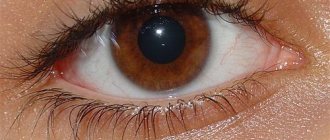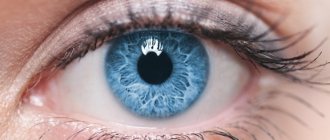- Published by: Laima Jansons
The organs of vision, protecting themselves from pathogenic influences or adapting to them, respond to the stimulus with an inflammatory process.
This is a collective concept denoting a set of inflammatory processes of different etiologies that affect different structures of the eye. Usually the problem occurs only in one area of the visual organs - discomfort can occur in the area of the lacrimal glands, cornea, eyelids, conjunctiva, blood vessels or orbit.
Causes
Irritation can occur due to infectious and non-infectious effects:
Inflammation of an infectious nature:
- consequences of measles, syphilis, gonorrhea, herpes, tuberculosis, scarlet fever, rheumatism, chlamydia, also microbial damage by staphylococcus or streptococcus, adenovirus;
Injuries:
- damage by foreign objects - glass fragments, sand;
- hit.
Aggressive effects of various substances or the environment:
- reaction to too bright light (photophobia);
- wind irritation;
- allergy;
- reaction to prolonged stress;
- exposure to acids and alkalis.
Conjunctivitis
Conjunctivitis, also known as inflammation of the eye, begins due to inflammation of the conjunctiva, the sensitive tissue that protects the surface of the eyeball and inner eyelid.
It often happens that conjunctivitis begins in one eye and then spreads to the other. Obvious signs of the disease include itching, red eyes and swollen eyelids. Often a sticky discharge oozes from the diseased eye or a crust forms around it. Sometimes the eyelids stick together, especially after sleep. The child may complain of sensitivity to light, a feeling as if there is sand in the eye, and blurred vision in the affected eye.
This is a highly contagious disease, usually caused by a viral or, less commonly, bacterial infection. In its mature form, the infection spreads from child to child in nurseries, kindergartens and schools, almost like a cold. At home, the disease can affect several family members, transmitted, for example, through bedding.
Newborns sometimes develop conjunctivitis because their tear ducts have not yet fully developed.
In addition to viral and bacterial infections, allergic conjunctivitis is caused by common allergens such as cigarette smoke and pollen.
As a rule, this disease is easily tolerated. However, if symptoms do not disappear after a couple of days of treatment, consult a doctor. And if your child's vision is blurry, tell the doctor immediately. This may be a symptom of a more serious condition.
Conventional medicine relies on antibacterial or antiallergic eye drops.
Causes of eye inflammation with redness
Chronic redness of the eyes can occur when there is a violation of tear production, as a result of which the organ suffers from a lack of moisture. In addition, allergies to medications, lenses, dust or food can cause redness.
Photo 1: To establish all the reasons causing this phenomenon, you need to consult a doctor to rule out various diseases. Source: flickr (MedilawTV).
Homeopathy for night blindness
It is reliably known that such a pathological condition occurs due to a deficiency of vitamin A (retinol), as well as B1 and PP. Being responsible for black-and-white vision, retinol is involved in the formation of the visual pigment - rhodopsin (visual purple). Night blindness can occur with degenerative diseases of the retina and damage to the optic nerve, but hypovitaminosis is the most common cause of this disease.
Normal night vision (left) and night blindness vision (right). Click on the image to enlarge it
To eliminate vitamin A deficiency, you should consume the following foods: butter, carrots and pumpkin, egg yolk, liver, broccoli, cheese, milk and cottage cheese. Increasing nutrition usually corrects the deficiency. Otherwise, buy retinol acetate capsules at the pharmacy, which are taken 1-2 per day with meals.
Homeopathy for night blindness can be used as an additional remedy that will speed up recovery.
Physostigma . The main medicine for this disease.
Belladonna and Nux . These products are used as an alternative to PHYSOSTIGMA.
Purulent inflammation of the eyes
Very often, purulent discharge from the eyes is the body’s reaction to various diseases - this is how it gets rid of waste products of bacteria. However, if this process is accompanied by pain and redness, then in this case we are talking about diseases of the organs of vision. Such signs may occur in purulent conjunctivitis caused by a pyogenic infection. It is brought onto the mucous membrane by unwashed hands or manifests itself as a result of damage to the body by viruses and bacteria.
Diseases of the visual organs, accompanied by redness and inflammation:
- Most often, irritation of the visual organs occurs due to conjunctivitis. The conjunctiva of the eye becomes inflamed due to mechanical, chemical or infectious effects.
- Inflammation of the eyelids: barley (the edge of the eyelid is affected by staphylococcus), meibomeitis (damage to the cartilage of the eyelid by coccal microbes), impetigo (the eyelid around the eyelashes is affected by staphylococcal pustules that have spread from the face), abscess and phlegmon (complications after previous eye diseases), blepharitis (inflammation of the eyelid by edge of eyelashes).
Diagnostics
The following types of examination are used to make a diagnosis:
- Biomicroscopy uses it to evaluate the tear film, its condition and the structures of the eye (eyelashes, conjunctiva, eyelid margins, cornea);
- Bacteriological testing is carried out to determine the sensitivity of bacteria to drugs. It is especially indicated to determine sensitivity in patients with recurrent blepharitis and patients in whom treatment is not effective;
- An eyelid biopsy is performed in patients with suspected cancer (carcinoma).
Demodectic blepharitis is diagnosed by examining eyelashes under a microscope (5 eyelashes from each eye).
Verification of the diagnosis occurs when mobile mites (6 or more) and their larvae are detected near the root of the eyelash.
A smaller number of ticks indicates a carrier state rather than a disease.
Differential diagnosis of anterior blepharitis is carried out with dry eye syndrome and cancer of the eyelid.
Homeopathic treatment of the problem
To maintain the health of the visual organs, homeopathy has long advised having the following products in your medicine cabinet:
For conjunctivitis:
- Acidum picrinicum (Acidum picrinicum) - against heavy discharge, inflamed eyelids;
- Aconitum (Aconitum) - against conjunctivitis resulting from injury;
- Apis (Apis) – for swollen and reddened eyelids, severe pain
- Clematis (Clematis) - for healing from purulent discharge;
- Mercurius corrosivus (Mercurius corrosivus) - eliminates photophobia, reduces lacrimation, relieves swelling;
- Nux vomica (Nux vomica) - helps eliminate traces of hemorrhages on the mucous membrane of the eyes.
For barley:
- Apis (Apis) – if barley occurs very often;
- Graphites (Graphitis) - to eliminate dryness and redness of the eyelids, with irritation from light;
- Lycopodium (Lycopodium) - irritation occurs on the bridge of the nose, accompanied by ulcers;
- Pulsanilla (Pulsatilla) - with the release of pus and with sticking of the eyelids.
Itching and burning in the eyes:
- Silica (Silica) – soreness of the eyelids and mucous membranes, photophobia;
- Staphysagria (Staphysagria) - for itchy eyelids;
- Thuja (Thuja) – in the case of eyelids sticking together from pus.
For abscesses and phlegmons:
- Hepar sulfur (Hepar Sulfur) - stimulates the flow of pus, relieves inflammation.
Homeopathic remedies act carefully, but effectively and comprehensively, relieving the symptom, while eliminating the source of irritation that causes inflammatory processes in the eyes.
Folk remedies
folk remedies Source: ayzdorov.ru
As mentioned earlier, blepharitis unites a large group of eye diseases, each of which is treated in its own way.
In this regard, it is necessary to begin treatment for one or another form of blepharitis only with the permission of a doctor, who will identify the cause of the disease and prescribe a course of treatment.
Blepharitis is treated with both medications and traditional methods.
The most effective result will be achieved with complex treatment of medical and folk remedies.
You should not self-medicate, as this can lead to the opposite effect.
Traditional medicine offers its own methods of treating eye diseases.
Let's look at some of them.
- Red rose petals are a good remedy for treating blepharitis. For treatment, rose oil made from flower petals is used. To prepare rose oil, take 30 grams. rose petals of dark shades, pour them with olive oil (400 ml) and leave in the sun for a week. Rub the eyelids with this oil several times a day. Rose oil has an antimicrobial effect, heals the skin, quickly regenerates it and renews the surface layer.
- Rose petals can be brewed as tea and taken internally. Together with rose oil, rose petal tea will refresh the skin and have a tonic effect.
- Burdock oil will have a positive effect on the skin around the eyes, which is also useful for lubricating the eyelids several times a day. Burdock oil, prepared from burdock (burdock) roots, tones the skin of the eyelids, has a bactericidal effect and is a good allergen.
- Lily of the valley flowers and leaves have a good anti-inflammatory effect. One tablespoon of herb is brewed with boiling water (1 glass) and left for 30 minutes. Soak cotton pads in the strained infusion and apply to the eyes for 20 minutes. It is advisable to apply lotions in the morning and evening until the illness passes.
- Aloe juice has anti-inflammatory and antimicrobial effects. Apply 2-3 drops of freshly squeezed juice to your eyes before bedtime.
- Freshly squeezed meadow clover juice has an effective effect. It is squeezed out and instilled 2 - 3 drops once a day. The cake is used as a compress on the eyes.
- For eye disease caused by a parasitized mite, you can use foam obtained from a solution of water and a finely grated piece of laundry soap as a lotion. Keep this compress for 5 minutes, wash it off and generously lubricate the skin with Vaseline.
- Thyme is also used to treat eyes. 1 tbsp. pour a spoonful of herbs into a glass of boiling water and leave for an hour. The resulting strained infusion is used to wash the eyes in the morning, after waking up, and in the evening, before going to bed.
You can use traditional methods only after consulting a specialist.
ADVANCED ACTIONS
Nutritional supplements
Zinc
— strengthens the immune system and accelerates skin healing. Dosage: children 2 years and younger - 5 milligrams; from 2 years and older - from 10 to 15 milligrams. Give it a 2 week cycle, then stop.
Quercetin
- has an antiallergic effect, which helps with conjunctivitis. Dosage: 6 milligrams per kilogram of weight, twice a day.
Medicinal plants
Combination of Echinacea and Hydrastis
- Helps the immune system fight bacterial or viral infection.
Acupressure
Use your thumb to gently press the point for 10-15 seconds. Do this on both sides of the body and repeat the procedure three times daily.
Yuyao
located on the curve in the middle of the eyebrow (directly above the pupil).
Gallbladder 20
- located below the base of the skull in the space between the two vertical neck muscles.










